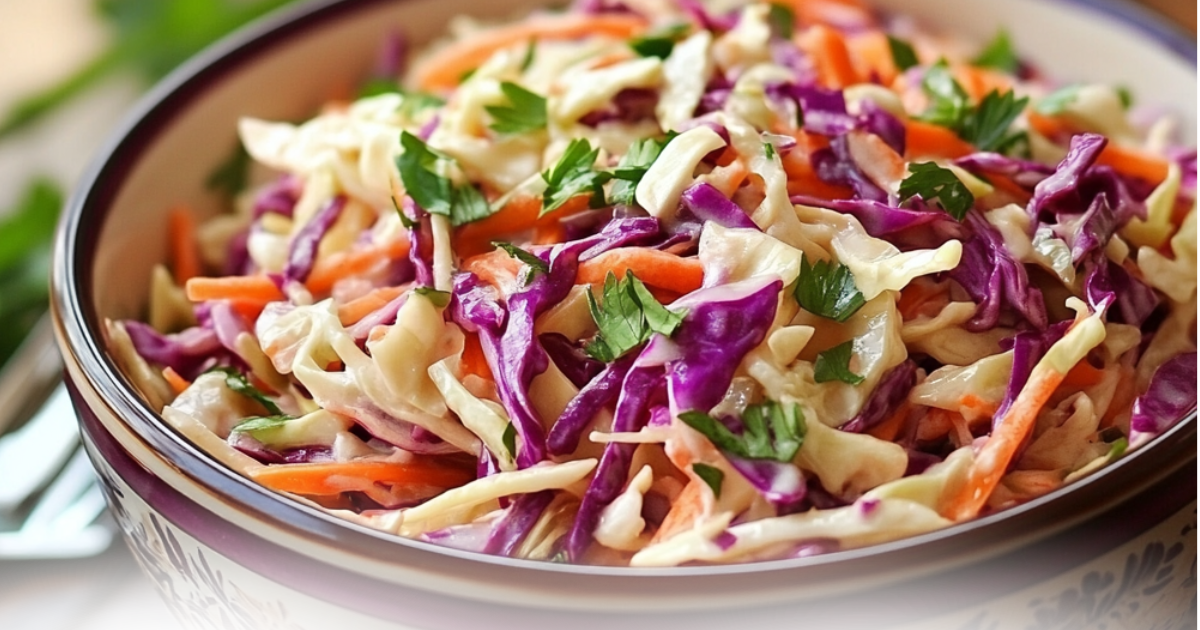When delving into the world of slaw, one might ponder: What’s the difference between coleslaw and hot slaw? This question is not merely about recipes; it involves history, culinary techniques, and personal preferences. Coleslaw, commonly recognized as a chilled, creamy dish made primarily with shredded cabbage, serves as a classic side dish worldwide. Hot slaw, on the other hand, is a heated version that often incorporates a tangy, spicy sauce. This article aims to explore these distinctions thoroughly, providing both fundamental insights and deeper understanding of each variant.
Table of contents
The Origins and Evolution of Coleslaw
Coleslaw originated in ancient Rome and evolved into the chilled, creamy salad we enjoy today. Its name, derived from the Dutch word koolsla (cabbage salad), highlights its simple roots. For more on its history, explore the article Coleslaw vs. Hot Slaw: Unpacking the Differences.
Hot slaw, on the other hand, emerged as a flavorful twist on coleslaw, especially in regions that embrace spicy, tangy dishes. By cooking the cabbage and infusing it with bold ingredients like mustard and chili, hot slaw delivers a distinct taste experience. Learn how hot slaw fits into diverse culinary traditions with tips from Perfect Shrimp Tacos with Slaw.
Discovering Hot Slaw: A Spicy Twist on Coleslaw
Hot slaw transforms the traditional coleslaw by adding heat, both in temperature and spice. What’s the difference between coleslaw and hot slaw? Primarily, the cooking method and seasoning adjustments. Traditional coleslaw is never cooked and often dressed with a vinegar or mayonnaise base. Conversely, hot slaw is typically sautéed and dressed with ingredients like vinegar, mustard, and chili peppers, offering a piquant alternative. This variant is particularly popular in regions where spicy food is cherished, adding a vibrant layer to dishes.

Classic Coleslaw Recipe
- Ingredients:
- 1 medium cabbage, finely shredded
- 2 carrots, grated
- 1/2 cup mayonnaise
- 2 tablespoons vinegar
- 1 tablespoon sugar
- Salt and pepper to taste

In preparing classic coleslaw, first mix the above ingredients in a large bowl. Then, chill for at least an hour before serving to allow the flavors to meld effectively. Consequently, this straightforward recipe highlights the simplicity and appeal of traditional coleslaw, clearly answering what’s the difference between coleslaw and hot slaw? by focusing on its cold, creamy texture and tangy flavor..
How to Prepare Hot Slaw
The preparation of hot slaw involves cooking the cabbage, which infuses it with a unique flavor and texture. To make hot slaw:
- Heat a pan over medium heat.
- Add oil, shredded cabbage, and other desired vegetables.
- Stir in vinegar, mustard, and, if preferred, hot peppers for spice.
- Cook until the cabbage is tender but still crisp.
This method showcases what’s the difference between coleslaw and hot slaw, emphasizing the cooked, spicy elements of hot slaw.
Coleslaw Recipe Variations
Coleslaw can vary widely beyond the classic recipe. Here are a few variations:
- Apple and Walnut Coleslaw: Adds crunch and sweetness.
- Blue Cheese Coleslaw: Introduces a creamy, savory flavor.
- Asian Coleslaw: Uses sesame oil and soy sauce for an Eastern twist.

These variations illustrate the versatility of coleslaw, adapting to different tastes and dietary preferences.
For creative variations like apple-walnut or Asian-inspired coleslaw, check out What Goes Well with Shrimp Tacos.
Creative Hot Slaw Variations
In exploring creative variations, what’s the difference between coleslaw and hot slaw becomes evident in the adaptability of hot slaw to various spices and cooking techniques. Specifically, hot slaw effortlessly incorporates bold flavors and diverse culinary methods, showcasing its versatility compared to traditional coleslaw. Moreover, this adaptability allows hot slaw to blend seamlessly into various regional cuisines, further distinguishing it from its chilled counterpart.
- Mexican Hot Slaw: Incorporates jalapeños and cilantro.
- German Hot Slaw: Features bacon and caraway seeds.
- Indian Hot Slaw: Uses curry powder and mustard seeds for an aromatic experience.
For inspiration, explore Best Reheating Tips for Shrimp Tacos, which highlights warming techniques ideal for hot slaw.
Nutritional Benefits of Coleslaw Ingredients
Both coleslaw and hot slaw offer substantial nutritional benefits due to their primary ingredient, cabbage. Rich in vitamins K and C, cabbage supports immune function and bone health. Additional ingredients like carrots enhance the vitamin A content, promoting eye health. Understanding what’s the difference between coleslaw and hot slaw includes recognizing that both can be part of a healthy diet, though the additional ingredients and preparation methods can alter their nutritional profiles.

Healthier Alternatives for Hot Slaw
When considering healthier versions of hot slaw, it’s vital to examine the traditional ingredients that make up this warm dish. Typically, hot slaw is made from shredded cabbage that is lightly sautéed with vinegar and sometimes mustard, providing a tangy and warm side dish. To make a healthier variant, you can substitute the common ingredients with alternatives such as:
- Apple cider vinegar for a milder acidity
- Olive oil instead of butter for sautéing
- Adding carrots or apples for natural sweetness and crunch
This approach maintains the essence of hot slaw while reducing fats and adding nutrients.
What’s the Difference Between Coleslaw and Hot Slaw? Pairing Coleslaw with Main Dishes
Coleslaw, known for its crisp texture and creamy or vinaigrette dressing, pairs exceptionally well with a variety of main dishes. Its cool and refreshing nature contrasts beautifully with:
- Grilled meats, such as barbecue ribs or chicken, where it offers a crisp counterpoint to smoky flavors
- Seafood, particularly fried fish, balancing the richness with its tangy profile
- Vegetarian burgers, providing a crunchy, creamy texture alongside plant-based patties
The versatility of coleslaw makes it an essential side for both casual and formal meals.
What’s the Difference Between Coleslaw and Hot Slaw? Serving Suggestions for Hot Slaw
Hot slaw, often served warm, complements a variety of comfort foods. Its warming nature makes it perfect alongside:
- Bratwursts, blending with the spices of the sausage
- Mashed potatoes, adding a vinegar kick to the creaminess
These pairings allow hot slaw to shine as a side dish that enhances the main course without overpowering it.
What’s the Difference Between Coleslaw and Hot Slaw? Coleslaw Through the Seasons
Coleslaw adapts wonderfully to seasonal ingredients, making it a year-round favorite. Here’s how you can adjust your coleslaw recipes to fit the season:
- Spring: Incorporate radishes and green onions for a fresh, peppery taste
- Summer: Add cucumber and tomatoes for a light, hydrating version
- Fall: Mix in roasted nuts and dried fruits for a hearty autumnal dish
- Winter: Use winter greens like kale or Brussels sprouts for added texture and flavor
This seasonal adaptability ensures that coleslaw remains a refreshing side dish all year long.
What’s the Difference Between Coleslaw and Hot Slaw? Hot Slaw for Every Occasion
Hot slaw fits a variety of occasions, from family dinners to holiday feasts. Depending on the event, you can tailor your hot slaw to suit the mood and menu. For instance:
- Family gatherings: Keep it simple with traditional ingredients like cabbage and vinegar
- Holiday meals: Enhance the dish with cranberries or chestnuts for a festive touch
- Summer picnics: Serve it slightly chilled to blend well with other picnic foods
Each variation of hot slaw can be designed to complement the theme and food choices of your gathering.
Find more pairing ideas in Coleslaw and Hot Slaw Differences.
FAQs: Tips and Tricks for Perfect Slaw
Creating the perfect slaw, whether coleslaw or hot slaw, involves some know-how. Here are some frequently asked questions and their answers to help you perfect your slaw recipes:
- How long should I let my coleslaw sit before serving? Ideally, refrigerate for at least an hour to let the flavors meld.
- Can I make hot slaw in advance? It is best served fresh but can be reheated gently to preserve its texture.
- What are the best dressings for coleslaw? Both mayonnaise-based and vinegar-based dressings work well, depending on your taste preference.
These tips ensure that your slaw is always flavorful and appealing.
What’s the Difference Between Coleslaw and Hot Slaw? Reader’s Coleslaw Creations
Our readers have shared some of their most innovative coleslaw creations. Incorporating unusual ingredients like pomegranate seeds, blue cheese, and wasabi into coleslaw recipes not only adds unique flavors but also turns a simple dish into a gourmet side. Such additions encourage culinary creativity and offer a refreshing twist on the traditional recipe.
Conclusion
Understanding the differences and similarities between coleslaw and hot slaw can significantly elevate your culinary experiences and meal planning. Indeed, each offers unique flavors, textures, and versatility, making them indispensable in diverse culinary situations. Whether you prefer the crispness of coleslaw or the warm tang of hot slaw, both dishes have a place in your recipe collection. Furthermore, by embracing variations and seasonal ingredients, you can keep these beloved slaws exciting and fresh all year round.

